
Unitronics
1
Vision™ OPLC™
User Guide
V1210-T20BJ
This guide provides basic information for Unitronics’ controllers V1210-T20BJ.
General Description
V1210 OPLCs are programmable logic controllers that comprise a built-in operating panel containing
a 12.1” Color Touchscreen.
Communications
▪ 2 isolated RS232/RS485 ports
▪ USB programming port (Mini-B)
▪ Isolated CANbus port
▪ The user can order and install an additional port. This may be
either Ethernet or serial.
▪ Communication Function Blocks include: SMS, GPRS, MODBUS
serial/IP; Protocol FB enables PLC to communicate with almost
any external device, via serial or Ethernet communications
I/O Options
V1210 supports digital, high-speed,
analog, weight and temperature
measurement I/Os via:
▪ Snap-in I/O Modules
Plug into the back of the
controller to provide an on-
board I/O configuration
▪ I/O Expansion Modules
Local or remote I/Os may be
added via expansion port or
CANbus.
Installation instructions and other data may be found in the module’s technical
specification sheet.
Information Mode
This mode enables you to:
▪ Calibrate the touchscreen
▪ View & Edit operand values, COM port settings, RTC and screen
contrast/brightness settings
▪ Stop, initialize, and reset the PLC
To enter Information Mode, press the touchscreen and maintain contact for
several seconds.
Programming
Software,
& Utilities
The Unitronics Setup CD contains VisiLogic software and other utilities
▪ VisiLogic
Easily configure hardware and write both HMI and Ladder control
applications; the Function Block library simplifies complex tasks
such as PID. Write your application, and then download it to the
controller via the programming cable included in the kit.
▪ Utilities
These include UniOPC server, Remote Access for remote
programming and diagnostics, and DataXport for run-time data
logging.
To learn how to use and program the controller, as well as use utilities such as
Remote Access, refer to the VisiLogic Help system.

Vision™ OPLC™,V1210-T20BJ
User Guide
2
Unitronics
Removable
Memory Storage
Micro-SD card: store datalogs, Alarms, Trends, Data Tables; export to Excel;
backup Ladder, HMI & OS and use this data to ‘clone’ PLCs.
For more data, refer to the SD topics in the VisiLogic Help system.
Data Tables
Data tables enable you to set recipe parameters and create datalogs.
Additional product documentation is in the Technical Library, located at www.unitronicsplc.com.
Technical support is available at the site, and from suppo[email protected].
Standard Kit Contents
Vision controller
Mounting brackets (x8)
3 pin power supply connector
Rubber seal
5 pin CANbus connector
CANbus network termination resistor
Battery (not installed)
Danger Symbols
When any of the following symbols appear, read the associated information carefully.
Symbol
Meaning
Description
Danger
The identified danger causes physical and property damage.
Warning
The identified danger could cause physical and property damage.
Caution
Caution
Use caution.
▪ Before using this product, the user must read and understand this document.
▪ All examples and diagrams are intended to aid understanding, and do not guarantee operation.
Unitronics accepts no responsibility for actual use of this product based on these examples.
▪ Please dispose of this product according to local and national standards and regulations.
▪ Only qualified service personnel should open this device or carry out repairs.
Failure to comply with appropriate safety guidelines can cause severe injury or property damage.
▪ Do not attempt to use this device with parameters that exceed permissible levels.
▪ To avoid damaging the system, do not connect/disconnect the device when power is on.
Environmental Considerations
▪ Do not install in areas with: excessive or conductive dust, corrosive or flammable gas,
moisture or rain, excessive heat, regular impact shocks or excessive vibration, in accordance
with the standards given in the product’s technical specification sheet.
▪ Ventilation: 10mm space required between controller’s top/bottom edges & enclosure walls.
▪ Do not place in water or let water leak onto the unit.
▪ Do not allow debris to fall inside the unit during installation.
▪ Install at maximum distance from high-voltage cables and power equipment.

Vision™ OPLC™,V1210-T20BJ
User Guide
Unitronics
3
UL Compliance
The following section is relevant to Unitronics’ products that are listed with the UL.
The model: V1210-T20BJ is UL listed for Hazardous Locations.
The model: V1210-T20BJ is UL listed for Ordinary Location.
UL Ordinary Location
In order to meet the UL ordinary location standard, panel-mount this device on the flat surface
of Type 1 or 4 X enclosures
UL Ratings, Programmable Controllers for Use in Hazardous Locations,
Class I, Division 2, Groups A, B, C and D
These Release Notes relate to all Unitronics products that bear the UL symbols used to mark products
that have been approved for use in hazardous locations, Class I, Division 2, Groups A, B, C and D.
Caution
▪ This equipment is suitable for use in Class I, Division 2, Groups A, B, C and D, or Non-
hazardous locations only.
▪ Input and output wiring must be in accordance with Class I, Division 2 wiring methods and in
accordance with the authority having jurisdiction.
▪ WARNING—Explosion Hazard—substitution of components may impair suitability for Class I,
Division 2.
▪ WARNING – EXPLOSION HAZARD – Do not connect or disconnect equipment unless power
has been switched off or the area is known to be non-hazardous.
▪ WARNING – Exposure to some chemicals may degrade the sealing properties of material
used in Relays.
▪ This equipment must be installed using wiring methods as required for Class I, Division 2 as
per the NEC and/or CEC.
Panel-Mounting
For programmable controllers that can be mounted also on panel, in order to meet the UL Haz Loc
standard, panel-mount this device on the flat surface of Type 1 or Type 4X enclosures.
Communication and Removable Memory Storage
When products comprise either USB communication port, SD card slot, or both, neither
the SD card slot nor the USB port are intended to be permanently connected, while the USB port is
intended for programming only.
Removing / Replacing the battery
When a product has been installed with a battery, do not remove or replace the battery unless the power
has been switched off, or the area is known to be non-hazardous.
Please note that it is recommended to back up all data retained in RAM, in order to avoid losing data
when changing the battery while the power is switched off. Date and time information will also need to
be reset after the procedure.
UL des zones ordinaires:
Pour respecter la norme UL des zones ordinaires, monter l'appareil sur une surface plane de type de
protection 1 ou 4X

Vision™ OPLC™,V1210-T20BJ
User Guide
4
Unitronics
Certification UL des automates programmables, pour une utilisation en
environnement à risques, Class I, Division 2, Groups A, B, C et D.
Cette note fait référence à tous les produits Unitronics portant le symbole UL - produits qui ont été
certifiés pour une utilisation dans des endroits dangereux, Classe I, Division 2, Groupes A, B, C et D.
Attention
▪ Cet équipement est adapté pour une utilisation en Classe I, Division 2, Groupes A, B, C et
D, ou dans Non-dangereux endroits seulement.
▪ Le câblage des entrées/sorties doit être en accord avec les méthodes
de câblage selon la Classe I, Division 2 et en accord avec l’autorité compétente.
▪ AVERTISSEMENT: Risque d’Explosion – Le remplacement de certains composants rend
caduque la certification du produit selon la Classe I, Division 2.
▪ AVERTISSEMENT - DANGER D'EXPLOSION - Ne connecter pas ou ne débranche pas
l'équipement sans avoir préalablement coupé l'alimentation électrique ou la zone est
reconnue pour être non dangereuse.
▪ AVERTISSEMENT - L'exposition à certains produits chimiques peut dégrader les propriétés
des matériaux utilisés pour l'étanchéité dans les relais.
▪ Cet équipement doit être installé utilisant des méthodes de câblage suivant la norme Class I,
Division 2 NEC et /ou CEC.
Montage de l'écran:
Pour les automates programmables qui peuvent aussi être monté sur l'écran,
pour pouvoir être au standard UL, l'écran doit être monté dans un coffret avec une surface plane de
type 1 ou de type 4X.
Communication et de stockage amovible de mémoire (carte mémoire)
Produits comprend un port USB de communication, soit un port carte SD ou les deux, ni le port SD, ni
le port USB ne sont censés être utilisés en permanence, tandis que l'USB est destiné à la
programmation uniquement.
Retrait / Remplacement de la batterie
Lorsqu'un produit a été installé avec une batterie, retirez et remplacez la batterie seulement si
l’alimentation est éteinte ou si l’environnement n’est pas dangereux.
Veuillez noter qu'il est recommandé de sauvegarder toutes les données conservées dans la RAM, afin
d'éviter de perdre des données lors du changement de la batterie lorsque l'alimentation est coupée. Les
informations sur la date et l'heure devront également être réinitialisées après la procédure
Inserting the Battery
In order to preserve data in case of power-off, you must insert the battery.
The battery is supplied taped to the battery cover on the rear of the controller.
1. Remove the battery cover shown on page 6. The polarity (+) is marked on the battery holder and
on the battery.
2. Insert the battery, ensuring that the polarity symbol on the battery is:
- facing up
- aligned with the symbol on the holder
3. Replace the battery cover.

Vision™ OPLC™,V1210-T20BJ
User Guide
Unitronics
5
Mounting
Dimensions
Note that the LCD screen may have a single pixel that is permanently either black or white.
Panel Support Installation
1. Insert the Panel Support tabs into
their location.
Note that the exact location varies
according to the panel model.
2. Pull on the Panel Support
until it locks (clicks) into
it’s place.

Vision™ OPLC™,V1210-T20BJ
User Guide
6
Unitronics
Panel Mounting
Before you begin, note that the mounting panel cannot be more than 5 mm thick.
1. Make a panel cut-out according to
the dimensions in the figure to the
right.
2. Slide the controller into the cut-
out, ensuring that the rubber seal
is in place.
3. Push the 8 mounting brackets into
their slots on the sides of the
controller as shown in the figure to
the right.
4. Tighten the bracket screws
against the panel. Hold the
bracket securely against the unit
while tightening the screw.
5. When properly mounted, the
controller is squarely situated in
the panel cut-out as shown below.
Note: For UL listed module, in order to meet the UL508 standard, panel-mount this device
on the flat surface of a Type 1 enclosure.
Caution
▪ The necessary torque is 0.45 N·m (4.5 kgf·cm).
\

Vision™ OPLC™,V1210-T20BJ
User Guide
Unitronics
7
Wiring
▪ Do not touch live wires.
▪ Install an external circuit breaker. Guard against short-circuiting in external wiring.
▪ Use appropriate circuit protection devices.
▪ Unused pins should not be connected. Ignoring this directive may damage the device.
▪ Double-check all wiring before turning on the power supply.
Caution
▪ To avoid damaging the wire, do not exceed a maximum torque of 0.5 N·m (5 kgf·cm).
▪ Do not use tin, solder, or any substance on stripped wire that might cause the wire
strand to break.
▪ Install at maximum distance from high-voltage cables and power equipment.
Wiring Procedure
Use crimp terminals for wiring; use 26-12 AWG wire (0.13 mm 2–3.31 mm2).
1. Strip the wire to a length of 7±0.5mm (0.250–0.300 inches).
2. Unscrew the terminal to its widest position before inserting a wire.
3. Insert the wire completely into the terminal to ensure a proper connection.
4. Tighten enough to keep the wire from pulling free.
Power Supply
The controller V1210-T20BJ requires either an external 12 or 24VDC power supply.
Permissible input voltage range: 10.2-28.8VDC, with less than 10% ripple.
▪ The power supply must include double insulation. Outputs must be rated as
SELV/PELV/Class 2/Limited Power.
▪ Do not connect either the ‘Neutral or ‘Line’ signal of the 110/220VAC to device’s 0V pin.
▪ Install an external circuit breaker. Guard against short-
circuiting in external wiring.
▪ Double-check all wiring before turning on the power
supply.
▪ In the event of voltage fluctuations or non-conformity to
voltage power supply specifications, connect the device
to a regulated power supply.
Earthing the OPLC
To maximize system performance, avoid electromagnetic interference by:
▪ Mounting the controller on a metal panel.
▪ Connect the functional earth terminal of the OPLC, and the common and ground lines of
I/Os, directly to the earth ground of your system.
▪ For ground wiring, use the shortest and thickest possible wire.

Vision™ OPLC™,V1210-T20BJ
User Guide
8
Unitronics
Communication Ports
This series comprises a USB port, 2 RS232/RS485 serial ports and a CANbus port. An additional
port may be ordered separately and installed. This port may be either Ethernet, or serial (COM 3).
For the most updated information regarding ports and their installation, please refer to the Technical
Library at www.unitronics.com.
▪ Turn off power before making communications connections.
Caution
▪ Always use the appropriate port adapters.
The USB port may be used for programming, OS download, and PC access.
Note that COM port 1 function is suspended when this port is physically connected to a PC.
The serial ports are type RJ-11 and may be set to either RS232 or RS485 via DIP switches, in
accordance with the table shown below.
Use RS232 to download programs from a PC, and to communicate with serial devices and
applications, such as SCADA.
Use RS485 to create a multi-drop network containing up to 32 devices.
Pinouts
The pinouts below show PLC port signals.
To connect a PC to a port that is set to RS485, remove the RS485 connector, and connect the PC to
the PLC via the programming cable. Note that this is possible only if flow control signals are not used
(which is the standard case).
RS232
RS485**
Controller Port
Pin #
Description
Pin #
Description
Pin #1
1*
DTR signal
1
A signal (+)
2
0V reference
2
(RS232 signal)
3
TXD signal
3
(RS232 signal)
4
RXD signal
4
(RS232 signal)
5
0V reference
5
(RS232 signal)
6*
DSR signal
6
B signal (-)
*Standard programming cables do not provide connection points for pins 1 and 6.
**When a port is adapted to RS485, Pin 1 (DTR) is used for signal A,
and Pin 6 (DSR) signal is used for signal B.
RS232 to RS485: Changing DIP Switch Settings
The ports are set to RS232 by factory default.
To change the settings, first remove the Snap-in I/O Module, if one is installed, and then set the
switches according to the following table.

Vision™ OPLC™,V1210-T20BJ
User Guide
Unitronics
9
RS232/RS485: DIP Switch Settings
The settings below are for each COM port.
Switch Settings
1
2
3
4
5
6
RS232*
ON
ON
ON
OFF
ON
OFF
RS485
OFF
OFF
OFF
ON
OFF
ON
RS485 with termination**
ON
ON
OFF
ON
OFF
ON
*Default factory setting
**Causes the unit to function as an end unit in an RS485 network
Installing a Snap-in I/O Module
▪ Before installing a Snap-In Module, ensure that the Communication Module Cover is
closed.
1. Remove the I/O connector cap shown on Page 6.
2. Line the circular guidelines on the Snap-in I/O Module with the slots on the controller as shown
below.
3 Apply even pressure on all 4 corners until you hear a distinct ‘click’. The module is now installed.
Check that all sides and corners are correctly aligned.
Removing a Snap-in I/O Module
1. Locate the four buttons on the sides of the controller, two on either side.
2. Press the buttons and hold them down to open the locking mechanism.
3. Gently rock the module from side to side, easing the module from the controller.

Vision™ OPLC™,V1210-T20BJ
User Guide
10
Unitronics
CANbus
These controllers comprise a CANbus port. Use this to create a decentralized control network using
one of the following CAN protocols:
▪ CANopen: 127 controllers or external devices
▪ CANLayer 2
▪ Unitronics’ proprietary UniCAN: 60 controllers, (512 data bytes per scan)
The CANbus port is galvanically isolated.
CANbus Wiring
Use twisted-pair cable. DeviceNet® thick shielded twisted pair cable is recommended.
Network terminators: These are supplied with the controller. Place terminators at each end of the
CANbus network.
Resistance must be set to 1%, 121Ω, 1/4W.
Connect ground signal to the earth at only one point, near the power supply.
▪ The network power supply need not be at the end of the network.
CANbus Connector

Vision™ OPLC™,V1210-T20BJ
User Guide
Unitronics
11
Technical Specifications
Power Supply
Input voltage
12 or 24VDC
Permissible range
10.2-28.8VDC
Max. current consumption
1A@12V
0.5A@24V
Battery
Back-up
7 years typical at 25°C, battery back-up for RTC and system data,
including variable data.
Replaceable
Yes, without opening the controller.
Graphic Display Screen
See Note 1
LCD Type
TFT
Illumination backlight
White LED
Display resolution, pixels
800x600 (SVGA)
Viewing area
12.1"
Colors
65,536 (16-bit)
Touchscreen
Resistive, analog
‘Touch’ indication
Via buzzer
Screen brightness
Via software (Store value to SI 9).
Keypad
Displays virtual keyboard when the application requires data entry.
Notes:
1. Note that the LCD screen may have a single pixel that is permanently either black or white.
Program
Memory size
Application Logic – 2MB, Images – 32MB, Fonts – 1MB
Operand type
Quantit
y
Symbol
Value
Memory Bits
8192
MB
Bit (coil)
Memory Integers
4096
MI
16-bit
Long Integers
512
ML
32-bit
Double Word
256
DW
32-bit unsigned
Memory Floats
64
MF
32-bit
Timers
384
T
32-bit
Counters
32
C
16-bit
Data Tables
120K dynamic RAM data (recipe parameters, datalogs, etc.)
Up tp 256K Flash data
HMI displays
Up to 1024
Program scan time
9 µsec per 1K of typical application

Vision™ OPLC™,V1210-T20BJ
User Guide
12
Unitronics
Removable Memory
Micro-SD card
Compatible with fast micro-SD cards; store datalogs, Alarms,
Trends, Data Tables, backup Ladder, HMI, and OS. See Note 2
Notes:
2. User must format via Unitronics SD tools utility.
Communication
Serial ports
2. See Note 3
RS232
Galvanic isolation
Yes
Voltage limits
20VDC absolute maximum
Baud rate range
300 to 115200 bps
Cable length
Up to 15m (50’)
RS485
Galvanic isolation
Yes
Voltage limits
−7 to +12VDC differential maximum
Baud rate range
300 to 115200 bps
Nodes
Up to 32
Cable type
Shielded twisted pair, in compliance with EIA RS485
Cable length
1200m maximum (4000’)
USB
See Note 4
Port type
Mini-B
Galvanic isolation
No
Specification
USB 2.0 compliant; full speed
Baud rate range
300 to 115200 bps
Cable
USB 2.0 compliant; up to 3m
CANbus port
1
Nodes
CANopen
Unitronics’ CANbus protocols
127
60
Power requirements
24VDC (±4%), 40mA max. per unit. See Note 5
Galvanic isolation
Yes, between CANbus and controller
Cable length/baud rate
See Note 5
25 m
100 m
250 m
500 m
500 m
1000 m*
1000 m*
1 Mbit/s
500 Kbit/s
250 Kbit/s
125 Kbit/s
100 Kbit/s
50 Kbit/s
20 Kbit/s
* If you require cable lengths over 500
meters, contact technical support.
Optional port
User may install a single Ethernet port, or an RS232/RS485 port.
Available by separate order.
Notes:
3. The standard for each port is set to either RS232/RS485 according to DIP switch settings. Refer to
the Installation Guide.
4. The USB port may be used for programming, OS download, and PC access. Note that COM port 1
function is suspended when this port is physically connected to a PC.
5. Supports both 12 and 24VDC CANbus power supply, (±4%), 40mA maximum per unit. Note that if
12 VDC is used, the maximum cable length is 150 meters.

Vision™ OPLC™,V1210-T20BJ
User Guide
Unitronics
13
I/Os
Number of I/Os and types vary according to module. Supports up to
1024 digital, high-speed, and analog I/Os.
Snap-in I/O modules
Plugs into rear port to create self-contained PLC with up to 62 I/Os.
Expansion modules
Local adapter (P.N. EX-A1), via I/O Expansion Port. Integrate up to 8
I/O Expansion Modules comprising up to 128 additional I/Os.
Remote adapter (P.N. EX-RC1), via CANbus port. Connect up to 60
adapters; connect up to 8 I/O expansion modules to each adapter.
Exp. port isolation
Galvanic
Dimensions
Size
313.1X244.6X59.1mm "12.32 ) X"9.62 X2.32"). See Note 6
Weight
1.7kg (60 oz)
Notes:
6. For exact dimensions, refer to the product’s Installation Guide.
Mounting
Panel-mounting
Via brackets
Environment
Inside cabinet
IP20 / NEMA1 (case)
Panel mounted
IP65/66/NEMA4X (front panel)
Operational temperature
0 to 50ºC (32 to 122ºF)
Storage temperature
-20 to 60ºC (-4 to 140ºF)
Relative Humidity (RH)
5% to 95% (non-condensing)
The information in this document reflects products at the date of printing. Unitronics reserves the right, subject to all applicable laws, at any time, at its sole
discretion, and without notice, to discontinue or change the features, designs, materials and other specifications of its products, and to either permanently or
temporarily withdraw any of the forgoing from the market.
All information in this document is provided "as is" without warranty of any kind, either expressed or implied, including but not limited to any implied warranties of
merchantability, fitness for a particular purpose, or non-infringement. Unitronics assumes no responsibility for errors or omissions in the information presented in
this document. In no event shall Unitronics be liable for any special, incidental, indirect or consequential damages of any kind, or any damages whatsoever arising
out of or in connection with the use or performance of this information.
The tradenames, trademarks, logos and service marks presented in this document, including their design, are the property of Unitronics (1989) (R"G) Ltd. or other
third parties and you are not permitted to use them without the prior written consent of Unitronics or such third party as may own them.
UG_V1210-T20BJ.pdf 07/22
-
 1
1
-
 2
2
-
 3
3
-
 4
4
-
 5
5
-
 6
6
-
 7
7
-
 8
8
-
 9
9
-
 10
10
-
 11
11
-
 12
12
-
 13
13
Unitronics V1210-T20BJ Logic Controllers Mode d'emploi
- Taper
- Mode d'emploi
- Ce manuel convient également à
dans d''autres langues
Documents connexes
-
Unitronics V530-53-B20B Mode d'emploi
-
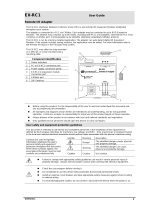 Unitronics EX-RC1 Remote I/O Adapter Mode d'emploi
Unitronics EX-RC1 Remote I/O Adapter Mode d'emploi
-
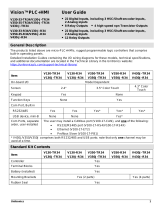 Unitronics V130-33-TR34 Rugged Programmable Logic Controllers Mode d'emploi
Unitronics V130-33-TR34 Rugged Programmable Logic Controllers Mode d'emploi
-
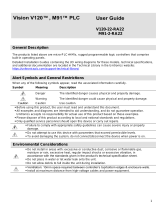 Unitronics Vision 120 Programmable Logic Controller Mode d'emploi
Unitronics Vision 120 Programmable Logic Controller Mode d'emploi
-
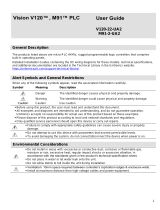 Unitronics V120 Rugged Programmable Logic Controllers Mode d'emploi
Unitronics V120 Rugged Programmable Logic Controllers Mode d'emploi
-
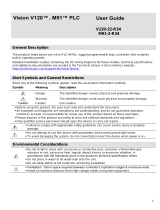 Unitronics V120-22-R34 Display units and HMIs Mode d'emploi
Unitronics V120-22-R34 Display units and HMIs Mode d'emploi
-
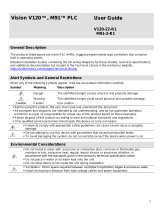 Unitronics V120-22-R1 PLC Controllers Mode d'emploi
Unitronics V120-22-R1 PLC Controllers Mode d'emploi
-
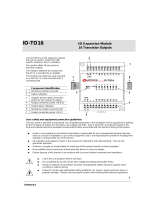 Unitronics IO-TO16 I/O Expansion Module Manuel utilisateur
Unitronics IO-TO16 I/O Expansion Module Manuel utilisateur
-
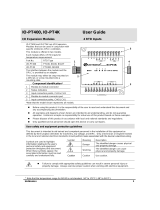 Unitronics IO-PT400 I-O Expansion Modules Mode d'emploi
Unitronics IO-PT400 I-O Expansion Modules Mode d'emploi
-
Unitronics JZ20-R31 HMI Display Unit Mode d'emploi





















